Two Books, One Good, One Excellent!
Reverse Innovation in Health Care:How to Make Value-Based Delivery Work
By Vijay Govindarajan and Ravi Ramamurti
Healthcare Solutions From A Distant Shore
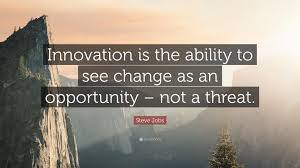
 Though still a pipe dream here in the United States, this kind of value-based competition is already a reality-in India. Facing a giant population of poor, underserved people and a severe shortage of skills and capacity, some resourceful private enterprises have found a way to deliver high-quality health care, at ultra-low prices, to all patients who need it. This book shows how the innovations developed by these Indian exemplars are already being practiced by some far-sighted US providers-reversing the typical flow of innovation in the world.
Though still a pipe dream here in the United States, this kind of value-based competition is already a reality-in India. Facing a giant population of poor, underserved people and a severe shortage of skills and capacity, some resourceful private enterprises have found a way to deliver high-quality health care, at ultra-low prices, to all patients who need it. This book shows how the innovations developed by these Indian exemplars are already being practiced by some far-sighted US providers-reversing the typical flow of innovation in the world.Govindarajan and Ramamurti, experts in the phenomenon of reverse innovation, reveal four pathways being used by health-care organizations in the United States to apply Indian-style principles to attack the exorbitant costs, uneven quality, and incomplete access to health care. With rich stories and detailed accounts of medical professionals who are putting these ideas into practice, this book shows how value-based delivery can be made to work in the United States. This “bottom-up” change doesn’t require a grand plan out of Washington, DC, agreement between entrenched political parties, or coordination between all players in the health-care system. It needs entrepreneurs with innovative ideas about delivering value to patients. Reverse innovation has worked in other industries. We need it now in health care.


VIJAY GOVINDARAJAN is one of the world’s leading experts on strategy and innovation and is Coxe Distinguished Professor at Dartmouth’s Tuck school of Business and a former Martin Bower Fellow at Harvard Business school. He is the author of a number of influential books, including the New York Times and Wall Street Journal bestselling Reverse Innovation.
RAVI RAMAMURTI, a top scholar in international business, is the University Distinguished Professor of International Business & Strategy and director of the Center for Emerging Markets at Northeastern University in Boston. His research and consulting work focuses on strategy and innovation by firms operating in, or from, emerging economies. He is the author or editor of seven books, including Understanding Multinationals from Emerging Markets.
“The ideas in Reverse Innovation in Health Care could save American health care billions of dollars. Vijay Govindarajan and Ravi Ramamurti have identified a rich new source of cost-saving medical innovation that deserves our most serious consideration.”
-Tony Cosgrove, MD, retired President and CEO, Cleveland Clinic
“Compliments to Vijay and Ravi for having the courage to write on a very emotional and sensitive topic. The ten reverse innovation lessons need to be deliberated upon earnestly so that millions of people who don’t have access to quality health care can benefit!”
-Rajit Mehta, Managing Director and CEO, Max Healthcare, India
“This book offers inspirational and practical insights on how to significantly improve the accessibility of health care in the face of ever increasing demand. This will be required reading for my leadership team.”
-Mary Ackenhusen, President and CEO, Vancouver Coastal Health, Canada
“Both powerful and insightful, Reverse Innovation in Health Care exposes what is wrong with the American health-care system. Through vivid examples, the authors show us that our nation’s biggest challenge and greatest opportunity is transforming the delivery system. To improve medical care, achieve superior outcomes, and lower costs, we must learn from the lessons of others around the globe. This book is a great place to begin and a must-read for both health-care leaders and policy experts.”
-Robert Pearl, MD, professor, Stanford University School of Medicine and Stanford Graduate School of Business; author, Washington Post bestseller, Mistreated: Why We Think We’re Getting Good Health Care- And Why We’re Usually Wrong
The Health Care Gamechangers:12 Innovators Around The World Who Are Reimagining Healthcare
By Dr Ashwin Naik
Foreword
By Stephen M. Sammut, Senior Fellow, Healthcare Management, Wharton School, University of Pennsylvania
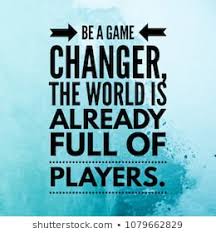
 Ashwin Naik provides us with an important commentary on one of the most pressing issues of our time: the imperative that healthcare transform on a worldwide basis from it’s current paradigm of ‘sick-care’ to true healthcare. He makes his case through a litany of illustrations of innovative approaches to care in multiple countries by a dozen health entrepreneurs that dare to challenge existing models in their own countries with new constructs for addressing local needs, but with universal implications. My only regret is that the list of gamechangers is short two entrepreneurs-the author himself and his co-founder of the Vaatsalya Hospitals System, Veerendra Hiremath-who from their headquarters in Bengaluru, India have addressed the critical need of providing primary and secondary care on an affordable and accessible basis to Indians living in tier two and tier three cities. I, for one, wished that Ashwin had not been so modest as to exclude his own story. The consolation for me is the old saying: “It takes one to know one” and applies well in this book. Ashwin knows healthcare gamechangers because he is himself the archetypal gamechanger.
Ashwin Naik provides us with an important commentary on one of the most pressing issues of our time: the imperative that healthcare transform on a worldwide basis from it’s current paradigm of ‘sick-care’ to true healthcare. He makes his case through a litany of illustrations of innovative approaches to care in multiple countries by a dozen health entrepreneurs that dare to challenge existing models in their own countries with new constructs for addressing local needs, but with universal implications. My only regret is that the list of gamechangers is short two entrepreneurs-the author himself and his co-founder of the Vaatsalya Hospitals System, Veerendra Hiremath-who from their headquarters in Bengaluru, India have addressed the critical need of providing primary and secondary care on an affordable and accessible basis to Indians living in tier two and tier three cities. I, for one, wished that Ashwin had not been so modest as to exclude his own story. The consolation for me is the old saying: “It takes one to know one” and applies well in this book. Ashwin knows healthcare gamechangers because he is himself the archetypal gamechanger.This book defines game-changing in healthcare as creating connectedness among a universe of related and unrelated, providers-sometimes new players-in fields directly and indirectly related to health. Wellness, after all, is a state of being and exists in concert with an ecosystem that provides nutrition, safe water, education, reliable energy and cultural food for the soul.
The cast of players in Ashwin’s narrative represent seemingly unrelated enterprises, but this is hardly the case. The lessons from each story interweave with one another. The commentary begins, for example, with Dr Rushika Fernandopulle of Iora Health in the United States. Iora Health’s premise challenges the “payer centric” model that has come to dominate the healthcare mindset and influence clinical decision-making. Iora assumes responsibility for a person’s health, not just the outcome of a procedure or consultation. Iora’s interventions occur as early as possible in primary care delivery and are able to better rationalize care and interventional strategies, thus producing healthier patients and a staff that fulfils their own vocational aspirations of delivering health.
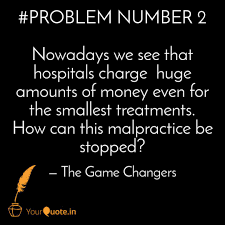
 Noora Health in India recognized early that patient care must extend from the professional and hospital settings to home and the community. When Edith Elliot founded Noora she recognized that the patient’s circle of family and friends could be prepared to provide essential care during the rehabilitative period. Beyond the patient as beneficiary, this circle of new providers also raises the awareness of health practices, behaviour and services in the community at large. This concept of engaging family and friends has been extended to end-of-life and palliative care by Suresh Kumar through his establishment of the Neighbourhood Network for Palliative Care, also in India. The committed attention of people serving their communities in this network- even under dire circumstances – reduces complications, improves outcomes, and maximizes the benefits of care during the palliative period.
Noora Health in India recognized early that patient care must extend from the professional and hospital settings to home and the community. When Edith Elliot founded Noora she recognized that the patient’s circle of family and friends could be prepared to provide essential care during the rehabilitative period. Beyond the patient as beneficiary, this circle of new providers also raises the awareness of health practices, behaviour and services in the community at large. This concept of engaging family and friends has been extended to end-of-life and palliative care by Suresh Kumar through his establishment of the Neighbourhood Network for Palliative Care, also in India. The committed attention of people serving their communities in this network- even under dire circumstances – reduces complications, improves outcomes, and maximizes the benefits of care during the palliative period.Ashwin does not pull punches when recognizing some of the inherent weaknesses in the healthcare system. He takes aims at hospitals, not on the basis of quality but on the disappropriate scope of influence that hospitals have on healthcare generally. He illustrates the alrternatives conceived by several healthcare entrepreneurs, among them Takashi Kawazoe of CarePro in Japan who sees all places where people gather as potential venues for providing care and information. This is a major shift in thinking about healthcare. While it is the case that many hospitals operate on a hub-and spoke basis, we often ignore the fact that health and wellness depend on the fabric of daily life. Japan is perhaps the best location to experiment with this model because the attention of the population to wellness is known globally.
The notion of “daily” and lifestyle care can also be extended to health maintenance in non-communicable disease, in particular the growing global problem of diabetes. Morgan Guerra, the founder of Previta in Mexico focuses on helping communities build better care and support structures for people living with diabetes. In a similar way, disseminated, community based-based primary care is the mission of Carlos Miguel Atencio’s Medicina Familiar in Venezuela where physicians are more integrated into wellness.
This theme of localization must also encompass improved efficiency in care. Ashwin makes the case that the administrative infrastructure surrounding healthcare consumes significant resources in its own right, but also contributes to a “discontinuity of care” wherein a patient may receive services from a multiplicity of unrelated providers. Even though the patient is at the center of concern of each of these providers, the exchange of information within them consumes valuable time and introduces the variables associated with miscommunication-the whisper down the lane paradox. Jos de Blok, himself a nurse, formed Buutzorg in The Netherlands to address these inherent inefficiencies by rethinking standards of care along the lines of organizational dynamics, team structures and operations research. Moreover, the patient is brought into the picture as an orchestrator of his own care.

 It should not surprise any readers that healthcare is a siloed enterprise built around competing venues for health services, as well as today around a vast array of specialities and sub-specialties. The medical establishment typically rejects inputs from outsiders to the system when alternative approaches are suggested, Resisting the status quo are innovators like Joost Van Engen, the founder of Healthy Entrepreneurs in The Netherlands who has jumped borders to African countries where he established mini-pharmacies that, in addition to providing healthcare essentials also promote preventive health through the training of local people who are integrated into their communities.
It should not surprise any readers that healthcare is a siloed enterprise built around competing venues for health services, as well as today around a vast array of specialities and sub-specialties. The medical establishment typically rejects inputs from outsiders to the system when alternative approaches are suggested, Resisting the status quo are innovators like Joost Van Engen, the founder of Healthy Entrepreneurs in The Netherlands who has jumped borders to African countries where he established mini-pharmacies that, in addition to providing healthcare essentials also promote preventive health through the training of local people who are integrated into their communities.Another fresh approach to thinking about healthcare needs was in the area of breast cancer detection through routine palpation and breast examination. While self-examination is a touchstone of public health programs, few women attain the level of insight or have the sensitivity to detect lesions. Enter Frank Hoffman, the founder of Discovering Hands of Germany, who realized that visually impaired people often have a hyper-developed sense of touch. Why not, he thought, train and deploy visually impaired people to serve as screeners in breast examination. This is a low cost but high-touch intervention into a growing problem, particularly in resource-scarce settings.
Finally, a treatment of gamechangers would not be complete without addressing changing the rules of the game itself. And this extends to bringing non-traditional resources to the setting. The story of Nalini Saligram of Arogya World in India is exemplary in this regard. Nalini had the fundamental insight that peer pressure and a sense of competition are powerful forces in all aspects of life but could be deployed as strategies in wellness, or in maintenance of health in the face of such illnesses as diabetes. Arogya World is engaged with creating corporate wellness programs driven by healthy competition, awareness, peer pressure and incentives. This is a strategy of modest cost and ultra-high impact that takes advantage of the centralization of people in the workplace. Naturally, lessons learned at work find their way into the household, particularly with nutrition.
This notion of changing the rules of the game by empowering people is put further into play by Vera Cordeiro’s Saude Crianca of Brazil. Saude Crianca’s program, “The Family Action Plan” (FAP), adopts an innovative methodology; it is based on the principle that poverty is one of the important causes of disease. The plan is mobilized fr intervention and follow-up care for families with sick children. It consists of a multi-disciplinary team that exerts integrated actions in the areas of health, education, citizenship, housing, and income, and is built based on each family’s needs. Besides overcoming the immediate difficulties inherent to the child’s post-hospitalization phase, the entities goal is to offer orientation and opportunities so that the family unit has its rights guaranteed and can enjoy a reasonable quality of life. This is a program that promotes human development through inclusion.

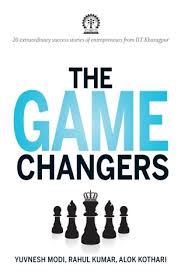 Finally, the rules of the prescription game are also ripe for change. Ashwin sets up this problem by observing that while the number of people being served by health systems has gone up exponentially, the service levels have dropped drastically. Businesses like banking and telecom innovated rapidly to meet growing demand and improve quality at the same time. Adopting the same model of serving more people in a short time in the healthcare sector has done the opposite and led to declining standards of care. Mark Swift, in creating Wellbeing Enterprises in the United Kingdom asked what’s wrong with this picture and why do we continue to apply the same tired solutions to macro and micro problems expecting different outcomes? Based in the northwest of England, Mark looked at how the care of people in his community was delivered. He analyzed the healthcare profile of his local community and considered the fact that the aging population was completely reliant on the medical community for their health and wellbeing. Through a program labelled Social Prescribing, Mark’s team looked at how they could develop the education of people in the community so that they did not overwhelm the healthcare system with ailments that could have been treated at home, or even worse, end up with a totally preventable disease because they did not know the effect their lifestyle was having oo their body. The focus of education became lifestyle management directed at healthy practices as an alternative to the distribution of pharmaceuticals.
Finally, the rules of the prescription game are also ripe for change. Ashwin sets up this problem by observing that while the number of people being served by health systems has gone up exponentially, the service levels have dropped drastically. Businesses like banking and telecom innovated rapidly to meet growing demand and improve quality at the same time. Adopting the same model of serving more people in a short time in the healthcare sector has done the opposite and led to declining standards of care. Mark Swift, in creating Wellbeing Enterprises in the United Kingdom asked what’s wrong with this picture and why do we continue to apply the same tired solutions to macro and micro problems expecting different outcomes? Based in the northwest of England, Mark looked at how the care of people in his community was delivered. He analyzed the healthcare profile of his local community and considered the fact that the aging population was completely reliant on the medical community for their health and wellbeing. Through a program labelled Social Prescribing, Mark’s team looked at how they could develop the education of people in the community so that they did not overwhelm the healthcare system with ailments that could have been treated at home, or even worse, end up with a totally preventable disease because they did not know the effect their lifestyle was having oo their body. The focus of education became lifestyle management directed at healthy practices as an alternative to the distribution of pharmaceuticals.
In summarizing the direction of his arguments and the wonderful stories in Ashwin’s narrative, I have been careful not to be a spoiler for the readers. There is a richness in the telling of these stories of healthcare and wellness innovation that should not be missed by anyone who cares about the needed transformation of health systems and services. Ashwin has done us a great service in explaining how modest shifts in thinking can produce major shifts in care and improvement in health. I hope you enjoy reading these narratives as much as I did.
Stephen M. Sammut
Philadelphia, PA USA
March 16, 2019
TEDxBigApple – Vijay Govindarajan – Reverse Innovation
Reverse Innovation in Global Health – Krishna Udayakumar
Dr. Ashwin Naik, MBBS, MS, Co-founder and CEO, Vaatsalya Healthcare
Mr Ashwin Naik Part 02 Sahayog Clip 01
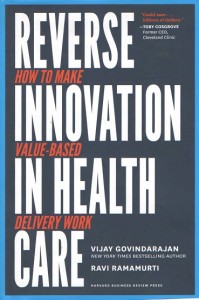
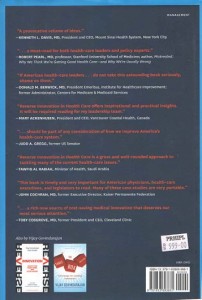
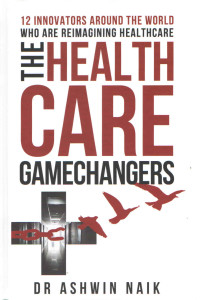
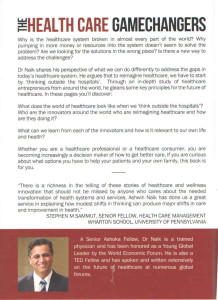
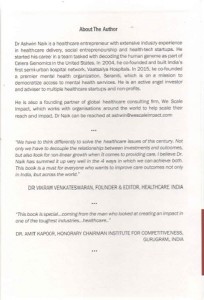
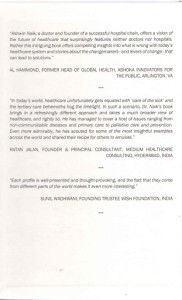
0 thoughts on “Two Books, One Good, One Excellent!”